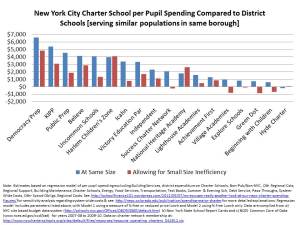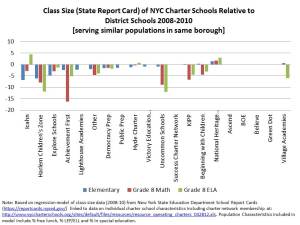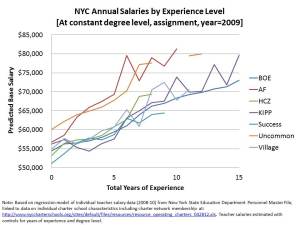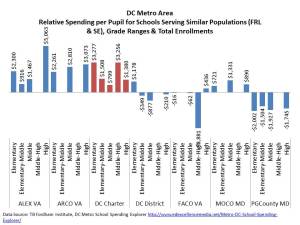School Finance 101: Children’s Constitutional Rights and School Funding: Why the Charter Funding Disparity Lawsuits in NY and DC are Misguided
Ah… another day, another smokescreen to distract state (and federal) courts from the real and substantive issue of equitable and adequate financing of America’s public schooling system. This one is brought to us from New York and Washington, DC., explained here by Dunn and Derthick in Education Next.
For years, opponents of school choice had a corner on the litigation market. But in a sign that charter schools have matured, lawsuits have recently been filed in Washington, D.C., and New York State demanding equitable funding. When the charter school movement was in its infancy, such litigation would have been politically dangerous. Why support charter schools if they may turn around and sue you? But charters are now so well established that they are fighting back against the second-class funding status that states and school districts have assigned them.
http://educationnext.org/modern-maturity-charter-schools/
Now, to be clear, these authors are no strangers to completely bizarre school finance arguments. Not too long ago, they thought it intriguing that the federal courts might entertain the possibility that unlimited local property taxation should be considered a federal constitutionally protected right – thus, any state regulation of, definition of, control over and limitations on property taxation violates individual liberties. Reconcile that view – a view of federal constitutional protection to raise and spend whatever you want on “your” schools (specifically via property taxes) – with their apparent support here for the assertion that states MUST be obligated to provide exactly equal revenue subsidy to charter schools as to district schools?[1]
Let’s have some fun and dissect this new one a bit – since Dunn and Derthick fail to provide any substantive analysis of the legal claims or supposed “facts” to support the assertion of “second-class funding status” specifically in the contexts of the litigation in question.
Typically (if there’s anything typical about this stuff), the judicial interpretation of state constitution education clauses [usual basis for bringing equity/adequacy school funding claims], is that children, regardless of who they are or where they live should have access to equal or adequate educational opportunities, where those opportunities are provided free of charge to the student (states differ on issues of fees, etc.). State courts have held legislatures to different standards of quality (adequacy), often based on the legislature’s own declarations of the desired (or mandated) outcomes and state courts have varied in their attention to “equal” versus “adequate,” arguably, though not clearly linked to differences in state constitutional language.
One of the contexts in question here is Washington, DC, which does not have a “state” constitution (not being a state and all) or therefore, an education clause. But, DC does have its own history of litigation pertaining to schooling equity in which a federal district court declared, in 1967 that the district’s segregated and financially unequal system of schooling “unconstitutionally deprive(d) the District’s Negro and poor public school children of their right to equal educational opportunity with the District’s white and more affluent public school children.”[2]
Notably, many courts have made clear that it is not the dollar inputs or publicly subsidized revenue amount that must be equally provided, but rather specific schooling resources – “essential resources” – required for provision of equitable and adequate education (sound basic education, thorough and efficient education, uniform system of schools), including differences in resources required for providing equal opportunities to children with varied educational needs.
The point here is that all children should have equitable access to constitutionally adequate opportunities. Consider a scenario where a child has the choice to attend one of 5 different district operated traditional public schools, a local privately operated/governed publicly subsidized charter school, a local private religious school for which the child might receive a partial subsidy (let’s say 50% of the public school expenditure), or attend any other private school at full tuition expense, or home school at full cost to parents/family.
The state need only guarantee that the child has access to an adequate and equitable education. The state is not necessarily obligated to fully finance at “adequate” expense, that child’s choice to home-school, to attend non-subsidized private school, or to pay the voucher rate at an equivalent of the “adequate” public district expense. Nor for that matter, is the state necessarily obligated to pay identically for the charter school, to the extent that the child (and every other child) in question has available, adequate educational options among which to choose. In other words, if the child chooses the lower funded school, when better funded schools are open/available to that student, are the student’s rights really violated?
Of course, the reality – the BIG ISSUE – is that the urban district as a whole might be inadequately subsidized by the state and thus all options available at no charge to the student (district, charter, voucher) are inadequately financed. If all options available to the student are inadequately and inequitably funded, then the child has a much stronger argument regarding the deprivation of their constitutional rights.
So, there are at least two major conceptual, legal gaps that should see these cases dismissed long before any discussion of “facts” ever occurs:
- The rights in question do not require equitable revenue/subsidy to the operators of charter schools versus district schools, but rather the provision of equitable and adequate publicly subsidized schooling (as measured by real resources and outcomes yielded by that funding) more broadly;
- That if a circumstance exists where a child and her family chooses a less subsidized alternative (homeschooling, full tuition private schooling, partially subsidized private schooling, OR publicly subsidized privately managed charter schooling) in the presence of adequately subsidized district schooling alternatives, the child’s rights are not likely violated. It’s their choice.
These cases likely die right here and never get to the point of deliberating the “facts” involved – that is, whether there truly exist the substantive disparities in equal educational opportunity between children attending district schools and charter schools in New York and Washington, DC.
The arguments are relying on junk analyses of disparities
Not only are these cases ill-conceived conceptually, but they seem at least partly driven by some of the most bogus “research” I have ever had the displeasure to review/critique – the University of Arkansas Department of Education Reform’s Charter Funding Disparities report. In fact, many if not most of the figures in the report that I attempted to reconcile with publicly available data were simply wrong, especially in cases where charter schools received their funding by pass-through from local public districts. Many of the supposed egregious funding gaps they identified between district schools and charter schools simply don’t exist and in some cases, the opposite was true.
First, here are links to a few key reports and research articles that compare charter school spending and revenues, which may be useful in the context of this litigation (were it ever to get that far):
- Baker, B. D., Libby, K., & Wiley, K. (2012). Spending by the Major Charter Management Organizations: Comparing Charter School and Local Public District Financial Resources in New York, Ohio, and Texas. National Education Policy Center. http://nepc.colorado.edu/publication/spending-major-charter
- Baker, B.D. (2014) Review of “Charter Funding: Inequity Expands.” Boulder, CO: National Education Policy Center. Retrieved [date] from http://nepc.colorado.edu/thinktank/review-charter-funding-inequity
- NYC Independent Budget Office (2011a). Charter Schools Housed in the City’s School Buildings get More Public Funding per Student than Traditional Public Schools. New York: Author. retrieved April 24, 2012, from http://ibo.nyc.ny.us/cgi-park/?p=272.
- NYC Independent Budget Office (2011b). Comparison of Funding Traditional Schools vs. Charter Schools: Supplement. New York: Author .Retrieved April 24, 2012, from http://www.ibo.nyc.ny.us/iboreports/chartersupplement.pdf.
- TB Fordham Institute’s DC Metro School Spending Explorer: http://www.edexcellencemedia.net/Metro-DC-School-Spending-Explorer/
Now let’s take a closer look at available data from New York City and Washington, DC in particular. Remember, it’s not entirely about the equality of the public subsidy rate, but rather about comparisons of the essential resources in question, given the population of students to be served. When it comes to New York City at least, reports on public subsidy rate comparisons have found that charter schools “co-located” in district buildings are actually funded higher than their district school counter parts, in stark contrast with the junk estimates of huge charter disadvantage identified in the UARK report. In my review of that report, I explain:
The UARK charter funding study reports total revenue per pupil for NYC public schools at over $24,000 and charter funding at $16,420, for a gap of 32%. By contrast, after sorting out district expenses on charter students, IBO found that charter schools in district facilities had a surplus subsidy around 4% and charter schools not in district facilities faced a deficit, but less than half of that identified by the Charter Funding Study. And the IBO study considered only public subsidy rate, not “all revenues” as proclaimed in the Charter Funding Report.
But again, what it really comes down to is more fine grained comparisons of resources available to children across schools. And as I’ve noted time and time again, New York City charter schools in particular, do not make strong case for deprivation. Indeed, they are widely varied, and some do have far fewer resources than others. But the biggest disparities are among high and low spending charter schools, not between district and charter schools.[3]Here’s quick walk through on NYC charter schools:
NYC charter schools, on balance, serve far less needy populations than do district schools in the same borough:
NYC charter schools, given their enrollments, grade ranges and locations, in many cases spend more per pupil – a lot more – than otherwise similar district schools.
With that money, NYC charter schools, on average, have provided smaller class sizes than district schools serving similar student populations.
And NYC charter schools, in many cases have actually paid their teachers more at similar degree and experience levels.
As someone who has testified time and time again regarding school funding disparities – and the connection between financial input deprivation and “real resource” deprivation – I’d have a pretty hard time asserting here that New York has established a system which systematically deprives children in charter schools – relative to district schools – of their constitutional rights.
It remains an entirely separate question whether children attending high need school districts are being provided a constitutionally adequate education in New York State – which they are not!
And about those inequities in Washington, DC. Little good publicly available information exists for comparing school site expenditures between district and charter schools in Washington DC by the same methods I apply in New York (which, are the methods broadly used and accepted in making funding comparisons across schools and districts in academic literature)[4]. But, a short while back, Mike Petrilli and colleagues at the TB Fordham Institute released their DC Metro School Spending Explorer web site and were kind enough to give me the opportunity to evaluate their data. The graph below presents an analysis comparable to the funding comparisons I make in New York City, specifically – comparing the per pupil operating spending of schools serving the same grade ranges, same shares of children qualified for free lunch and same shares of children in special education programs.
Here, I find that as in New York City, DC charter schools are spending, on average, substantially more per pupil than “otherwise similar” district schools:
Now, I do have some hesitation about these data, in that even to me, it seems that the differences in spending may be overstating charter expenditure relative to similar district school expenditure. But even with some correction (if warranted), it’s unlikely that one would find the supposed substantial and systematic deprivation of charter schools relative to district schools asserted in the thoroughly discredited UARK report.
The bigger issue: Actual equitable and adequate funding!
The big issue, which I’ve addressed time and time again, is that states (and Washington DC) must provide equitable and adequate financing for the system as a whole – which requires substantive additional support in high need communities – communities with large shares of children and families in poverty, racial minorities and children with limited English language proficiency. When the system is financed equitably and adequately, then so too can charter schooling be financed equitably and adequately.
This new pissing match between charter and district schools spawned by charter advocates (perhaps even initiated by the bogus UARK report) to gain greater access to the limited pool of resources currently available to largely urban, high need public districts is yet another distraction – a smoke screen – and just the kind of smokescreen that many state policymakers desire – again removing the focus from the bigger issue. No need to raise taxes to actually fully and equitably finance the public schooling system? We merely need to force local public districts (regardless of what they have available to them) to provide more funding to charter schools – even if the math doesn’t add up (that is, if the source of funds isn’t adequate for all eligible children, then it’s neither adequate for financing district, nor charter schools, nor other alternatives).
But then again, perhaps that’s the whole point. Let’s hope the courts can see through this one (like this BS), discard it quickly, and get back to the more important business at hand!
Notes
[1]Notably, Dunn & Derthick don’t so much come out and argue that plaintiffs are correct in this case, but do use plenty of language suggesting they support the charter point of view, including broad acceptance of “second class funding status”
[2]http://law.justia.com/cases/federal/district-courts/FSupp/269/401/1800940/
[3]More information on charter schools around the rest of the state can be found in this article: Bifulco, R., & Reback, R. (2014). Fiscal Impacts of Charter Schools: Lessons from New York. Education, 9(1), 86-107.
[4]See literature review here: Baker, B. D. (2012). Rearranging Deck Chairs in Dallas: Contextual Constraints and Within-district Resource Allocation in Urban Texas School Districts. Journal of Education Finance, 37(3), 287-315.
This blog post has been shared by permission from the author.
Readers wishing to comment on the content are encouraged to do so via the link to the original post.
Find the original post here:
The views expressed by the blogger are not necessarily those of NEPC.





